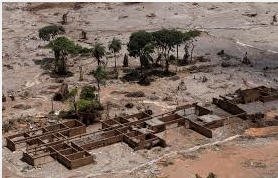Brazil’s federal government on Friday reached a multibillion-dollar settlement with the mining companies responsible for a 2015 dam collapse that the government said was the country’s worst-ever environmental disaster.
SAO PAULO — Brazil’s federal government on Friday reached a multibillion-dollar settlement with the mining companies responsible for a 2015 dam collapse that the government said was the country’s worst-ever environmental disaster.
Under the agreement, Samarco — a joint venture of Brazilian mining giant Vale and Anglo-Australian firm BHP — will pay 132 billion reais ($23 billion) over 20 years. The payments are meant to compensate for human, environmental and infrastructure damage caused by the release of an immense amount of toxic mining waste into a major river in southeastern Minas Gerais state, killing 19 people and ravaging entire villages.
”We are fixing a disaster that could have been avoided, but wasn’t,” President Luiz Inácio Lula da Silva said in a hall of the presidential palace, surrounded by governors of the affected states, members of his administration, reporters and victims.
Lula’s speech, filled with criticism of what he called the mining companies’ irresponsibility in chasing profit over safety, was met with applause from the audience.
The toxic sludge — enough to fill 13,000 Olympic-size swimming pools — flowed down the Doce River for 420 miles to the Atlantic Ocean, contaminating waterways and coastal areas in two neighboring states.
The mining companies told the federal government during negotiations that they had already paid 38 billion reais ($6.7 billion) in reparations. In a statement Friday, Samarco said the agreement allowed for the resolution of lawsuits related to the dam rupture.
Rodrigo Vilela, Samarco’s president, said in the statement that the collapse was a watershed in their history, which they ”deeply regret and will never forget.”
”The agreement signed today reinforces Samarco and its shareholders’ commitment to people, communities and the environment, ensuring the continuation of full and definitive repair and compensation for the damages,” he added.
Read full report





